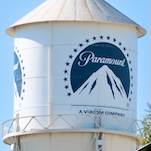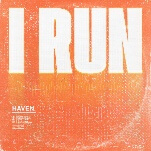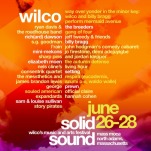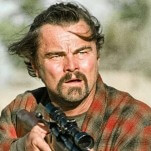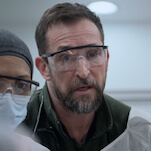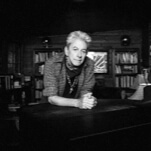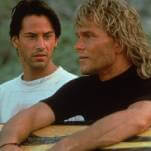The New Cult Canon: Primer
As I promised/threatened when I started this
project, the term "cult movie" would be defined in many different ways, but one
of the major buzzwords for me is "obsession," movies that inspire people to
watch them compulsively. The vast majority of films are disposable, easily
grasped the first time around and yielding next to nothing on the second or
third viewing. Cult movies are another story: Sometimes they create worlds so
singularly seductive and inviting that they beckon people back for another
visit, like some favorite exotic vacation spot. Other times, they're so
intricately constructed that viewers want to puzzle over their mysteries. (It's
little wonder that Donnie Darko remains one of this generation's biggest cult
phenomena, because it satisfies both scenarios at once.) Shane Carruth's
stunning debut feature Primer unquestionably falls into the latter category,
though I hasten to add that the film's resourceful cinematics are what endear
it to me the most.
Primer was shot on Super 16mm for $7,000. Let that sink
in a moment. On low-budget independent productions, film stock can be
prohibitively expensive, hence the move toward shooting on digital video, which
allows the camera to run for eternity without costing more than a stack of
dimes. Only recently—thanks to films like David Fincher's Zodiac, Nuri Bilge Ceylan's Climates, and Michael Haneke's Caché—I've started to
come around to the idea that hi-definition video could be a viable substitute
for film, and I'm certain that digital technology will one day be so good that
pondering celluloid's extinction won't make me want to curl up in a fetal ball
and sob.
But back in 2004, when Primer deservedly won the Grand
Jury Prize at Sundance, there was plenty of reason for skepticism. It had been
nearly a decade since Lars von Trier and his Danish cronies signed off on their
Dogme '95 manifesto, and independent filmmakers of all stripes seemed
determined to degrade the medium as thoroughly as possible. The economics of
shooting on film are debatable, as Primer makes startlingly clear, but too many
filmmakers then and now use video as an excuse for visual indifference. And
most gallingly of all, the Dogme '95 guys seemed to believe that cinematics of
any kind are a bourgeois indulgence—that if you strip away the artifice
of lighting, set design, unnatural sound, and non-handheld camera movement,
you're somehow keeping it real.
For a laugh, I did a search of past reviews on
this site where I commented on the use of digital video. Between barbs about
films that look "filtered through what appears to be an old sweatsock" (Virgin) or mimic "the high grain
of a QuickTime movie" (The Center Of The World), I came across this
passage, on Jennifer Jason Leigh and Alan Cumming's forgettable ensemble comedy The Anniversary Party:
Aside from crummy picture
quality, one of the major drawbacks of digital video is that its cheapness and
flexibility make filmmaking too easy, encouraging conceptual laziness and
self-indulgence more often than inspired experimentation.
To my mind, Primer is the opposite of movies
like The Anniversary Party: By shooting on 16mm with a four-figure budget,
Carruth couldn't afford to be conceptually lazy or self-indulgent. In fact, he
couldn't afford to shoot more than one take per setup, because burning through
film stock is equivalent to burning through money. He had to get it right the
first time.
And even with no margin for error, he had the
audacity to shoot several long takes and a few complicated dolly shots.
Necessity being the mother of invention, Carruth had no choice but to plan the
film scrupulously and think it through on every level, which is not the sort of
rigor one associates with improvisational nothings like The Anniversary
Party.
The genius of Primer is that form matches
content: Carruth is telling a story about a couple of young inventors working
out of a garage, so it follows that he'd take a similarly analog approach to
filmmaking. An autodidact with an engineering background, Carruth shot the film
in his native Dallas, with his parents' house serving as a primary location.
From the very first shot—which makes the windows of a darkened garage
look like the view from an alien spaceship—the film has an eerie,
fluorescent-tinged ambience that's appropriate for science fiction and true to
the life of a scientist. Add to that an underlay of computer-generated music
(also composed by Carruth, who wanted the score to move from simple acoustic sounds
to something more ethereal as the film progressed), and Primer feels as much like an
ingenious homemade gizmo as the time machine its characters invent.
Frustrated in his efforts to find suitable actors
to carry across his deadpan techno-speak dialogue, Carruth cast himself and David
Sullivan as Aaron and Abe, a couple of hardware wizards looking for that big entrepreneurial
breakthrough. Though they work with a couple of partners out of Aaron's garage,
Aaron and Abe are secretly constructing a machine called "the box," which they
originally envision as a superconductor that can degrade gravity on an object,
but which has some amazing unintended side effects. One of those side effects
is that it operates on a feedback loop, and puts out slightly more voltage than
they're putting in. In this clip, Aaron demonstrates this remarkable discovery:







